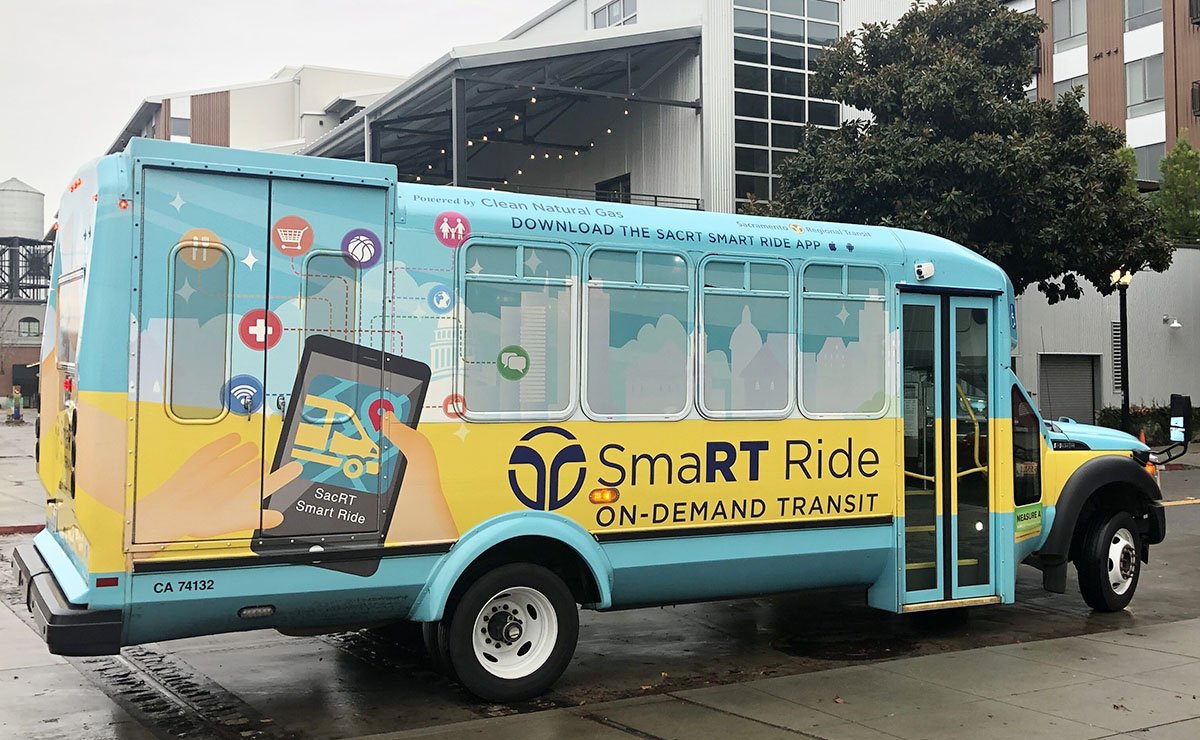
Think of them as a cross between a city bus and an Uber. They are on-demand, app-based passenger shuttles, and they are beginning to pop up across the U.S. as cities work to expand mobility options.
These microtransit vehicles are often cheaper than hailing a personal car, and unlike other forms of mass transit, they aren’t constrained by timetables and fixed routes. Passengers summon shuttles using an app. Some of the minibuses operate door to door; others pick up and drop off passengers at “virtual stops” near their desired location. They also operate on college campuses.
Among the companies powering these shuttle services are New York-based Via Transportation Inc. and Durham, N.C.,-based Transloc Inc., a subsidiary of Ford Smart Mobility.
Via announced on Monday that it had created the nation’s largest on-demand microtransit system, expanding the SmaRT Ride service in Sacramento, Calif., to 42 vehicles. Via operates the service in partnership with the Sacramento Regional Transit District.
This month, the Worcester Regional Transit Authority announced that it had won a grant of nearly $460,000 to pilot an on-demand microtransit service through Via in Westborough, Mass. Via has also worked with transit authorities in Los Angeles, Seattle and Austin and Arlington, Texas, and in 2017 formed a joint venture with Daimler called ViaVan to operate on-demand ride-sharing services in Europe.
In many cases, transit agencies are using their micromobility shuttles to ferry passengers to and from public transportation hubs. In June, for instance, Tri Delta Transit in eastern Contra Costa County, near San Francisco, launched the Tri MyRide shuttle, which operates near two Bay Area Rapid Transit stations.
Similarly, in East St. Louis, Ill., the St. Clair County Transit District’s SCCTD Flyer helps customers get to and from four MetroLink light-rail stations and 11 Metrobus routes. The Tri Delta and St. Clair County shuttles are among several across the country that run on Transloc’s app.
Advocates see these types of services as a potential lifeline for mass transit agencies whose ridership numbers have declined as customers opt to call Uber or Lyft rather than stand at a bus stop.
Others say the solution isn’t so simple.
“With its flexible routing, microtransit can seem like the solution to longstanding first-mile/last-mile challenges. But microtransit has inherent limitations,” says a report by New York-based think tank TransitCenter.
It says providing door-to-door service is inefficient, making microtransit more generally expensive than fixed-route buses. It also says such projects draw away funds that could be better used to improve pedestrian access to bus stations and stops.
— Leslie J. Allen
What you need to know
Volvo building U.S. battery assembly plant Volvo will build its own U.S. battery assembly plant as it readies a line of electric vehicles for this market. The expansion is part of a previously announced $600 million project that the Swedish automaker has begun at its plant in Ridgeville, S.C., which includes a second production line and Volvo Car University. Volvo will create an electric version of its next XC90 crossover and build it at the plant starting in late 2022. The factory, 45 miles northwest of Charleston, employs about 1,500 workers building the S60 sedan.
Visteon integrates remote driver with Portland, Ore., startup Self-driving vehicles that encounter tricky scenarios may soon have more options for determining how to proceed. Visteon, a supplier of cockpit electronics, is working with startup Designated Driver to add remote-control capabilities to its autonomous-driving platform. Remote human monitors could either send vehicles instructions on how to navigate, or in some cases, control cars themselves and steer them through complex scenarios the cars cannot handle on their own.
GM revamps digital platform for EV future More than two years before a new vehicle is built, General Motors engineers test the power steering, turn signals and driver-assist technology such as Super Cruise — all from a lab at its engineering hub. It’s made possible by GM’s new digital platform, which will be integrated into most of the automaker’s vehicles by 2023. It debuted on the 2020 Cadillac CT5 and will be part of the upcoming Cadillac CT4 and redesigned Chevrolet Corvette, Suburban and Tahoe. GM says the platform — referring to how all of a vehicle’s electronics are interconnected, not the underpinnings of the vehicle itself — is the backbone the company needs to enhance cybersecurity, increase data speeds, offer over-the-air updates and fulfill its commitment to building more electric vehicles.
Roundup
After nearly two years of collaboration, Magna International has decided to end its self-driving technology partnership with Lyft.
A new pragmatic focus on helping drivers, not replacing them
Toyota makes a $394 million bet on flying taxis.
GM to revive Hummer name with electric pickups, SUVs
Hyundai, Kia invest $110 million in UK electric van startup Arrival
5 cool things at CES
Honda, Isuzu power up fuel cell partnership for heavy-duty trucks
New Jersey lawmakers pass legislation for EV rebates.
Is this new technology going to pay off?
NTSB to determine cause of 2018 fatal Tesla crash in California
Electra Meccanica plans more U.S. kiosks to sell single-seat Solo EV in U.S
Toyota’s hybrid strategy a bright spot in a down year
Lyft forms advisory council to improve platform safety
A CES conversation with Microsoft’s Tara Prakriya
Toyota AI Ventures won’t stand in way of ideas
Waymo’s long-term commitment to safety drivers in autonomous cars
What’s a passenger to do? Ask suppliers.
Car apps aren’t connecting, say two members of J.D. Power’s Automotive Consulting group.
Toyota Kentucky plant starts production of RAV4 Hybrid
Brain food
ZF inspired by the evolution of Microsoft
Last mile
Alexa, set navigation for Flavortown.
